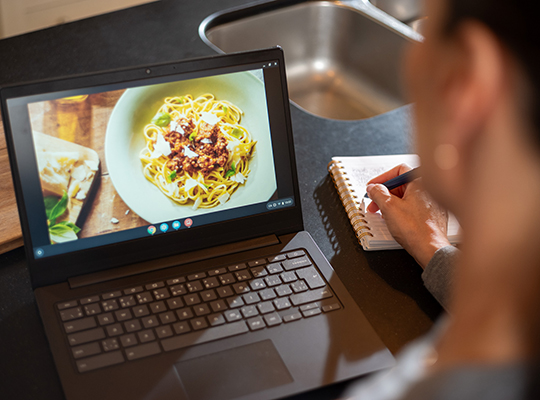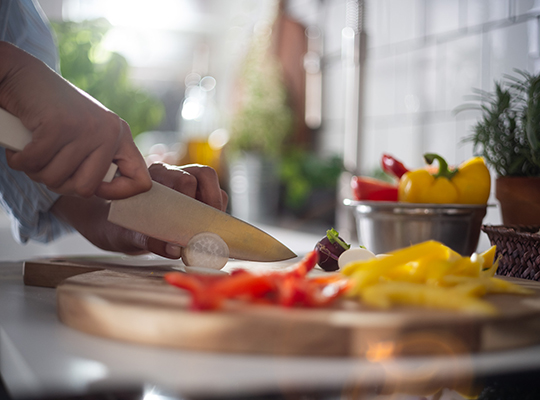
From the farm to your table, everyone has a role to play in making the best choices for the environment, including governments, producers, businesses and consumers.
As a consumer, learn how to avoid sending food waste to landfills where it creates greenhouse gases, to make sure the resources used to produce our food are not wasted and to support ecofriendly farming and processing practices.
When it comes to food, changing daily habits can lead to a greener future.
How to make environmentally friendly food choices
When it comes to decisions related to food, changing daily habits can lead to a greener future.
- Choose Canadian foods
- Plan your meals
- Manage food freshness
- Understand date labelling
- Cook with less waste
- Grow your food
See what farmers and food and beverage processors are doing.
Choose Canadian foods
Where possible, support the many Canadian farmers and food and beverage processors who are committed to producing quality food while protecting the environment.

- Look for food products with claims such as Made in Canada or Product of Canada on their label.
- Buy Canadian fresh, frozen, or canned produce.
- Subscribe to a local food box program.
- Visit a farmers' market, an on-farm market or pick-your-own farm near you.
- Take a culinary tour to discover locally produced foods.
Did you know?
In addition to Made in Canada and Product of Canada claims, Canadian food products can be identified by other descriptive words such as: Canned in Canada, Packaged in Canada, Prepared in Canada, Processed in Canada. When you purchase foods with these claims, you are supporting Canadian food processors.
Learn more about buying local foods
Plan your meals
Meal planning not only helps you to reduce food waste, but it also saves time and money.

- Check what food you already have at home to see what you need to buy.
- Make a list and stick to it. Avoid impulsive buying.
- Consider buying imperfect vegetables and fruits.
- Explore different food waste reduction apps or programs.
- If eating out, bring an empty reusable container to bring leftovers home with you.
- If the meal is only available in a large portion, consider sharing.
Learn more about planning your meals
Manage food freshness
Food will last longer if stored properly, helping to reduce food waste.

- Keep your fridge at 4°C and your freezer at −18°C.
- In the fridge and pantry, place perishable foods or foods you have already opened at the front as a reminder to eat them first.
- Freeze, can, dry or preserve fresh produce to extend its lifespan.
- If something might go bad soon, freeze it to use later and put a date on it.
- Have canned, frozen or dried foods on hand – they have a longer life which can lead to less waste.
Learn more about managing food freshness
Understand date labelling
The food you want to throw out might still be good. Make sure you understand date labelling.

- Expiration dates and best-before dates are different. Expiration dates are required on only a small number of specific foods, such as infant formula and meal replacements. When foods are past their expiry date, they are no longer safe to eat.
- A best-before date is not an indicator of food safety—it's about freshness, nutritional value and quality. So use your judgment when deciding if food can be eaten.
Learn more about date labelling
Cook with less waste
Consider these easy habits to reduce food waste.

- Use the most perishable items first.
- Cook using leftovers. Quiche, stir-fries, soups and casseroles use up leftover veggies and protein.
- Freeze your food scraps to make a broth later.
- Think about composting your food waste:
- Find out if your community has a compost program. Check out the schedule or drop-off locations.
- Start a food waste compost at home.
- Have a bin at hand in which you can easily put your food waste.
- Freeze food waste to prevent odours and flies and help with the composting process.
Learn more about cooking with less waste
Grow your food
Growing your own food can be very rewarding while also benefiting the environment by helping pollinators thrive and greening your community. Use the tips below to start growing your own food.

- Enrich your garden soil by using your own compost or check if your municipality offers free compost.
- Learn how growing some plants together benefits them.
- No yard? Look for community gardens in your area or grow plants in pots, both outdoors and on windowsills.
What farmers and food and beverage processors are doing
Canadian farmers and food and beverage processors are dedicated to putting quality food on our tables while protecting the environment for future generations. Meet the people behind your food and discover what they are doing for the environment.

 Back to top
Back to top


